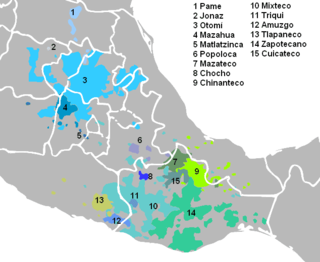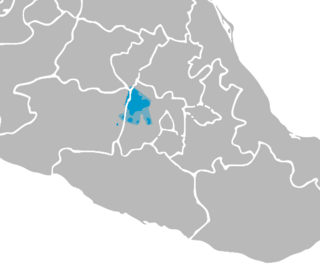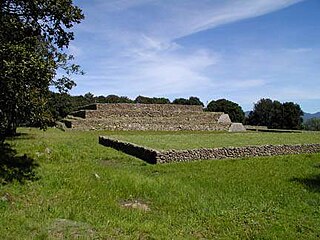
The Chinantec or Chinantecan languages constitute a branch of the Oto-Manguean family. Though traditionally considered a single language, Ethnologue lists 14 partially mutually unintelligible varieties of Chinantec. The languages are spoken by the indigenous Chinantec people who live in Oaxaca and Veracruz, Mexico, especially in the districts of Cuicatlán, Ixtlán de Juárez, Tuxtepec and Choapan, and in Staten Island, New York.

Mesoamerican languages are the languages indigenous to the Mesoamerican cultural area, which covers southern Mexico, all of Guatemala, Belize, El Salvador, and parts of Honduras, Nicaragua and Costa Rica. The area is characterized by extensive linguistic diversity containing several hundred different languages and seven major language families. Mesoamerica is also an area of high linguistic diffusion in that long-term interaction among speakers of different languages through several millennia has resulted in the convergence of certain linguistic traits across disparate language families. The Mesoamerican sprachbund is commonly referred to as the Mesoamerican Linguistic Area.

The Oto-Manguean or Otomanguean languages are a large family comprising several subfamilies of indigenous languages of the Americas. All of the Oto-Manguean languages that are now spoken are indigenous to Mexico, but the Manguean branch of the family, which is now extinct, was spoken as far south as Nicaragua and Costa Rica. Oto-Manguean is widely viewed as a proven language family.

The Mazahuas are an Indigenous people of Mexico, primarily inhabiting the northwestern portion of the State of Mexico and small parts of Michoacán and Querétaro. The largest concentration of Mazahua is found in the municipalities of San Felipe del Progreso and San José del Rincón of the State of Mexico. There is also a significant presence in Mexico City, Toluca and the Guadalajara area owing to recent migration. According to the 2010 Mexican census, there are 116,240 speakers of the language in the State of Mexico, accounting for 53% of all indigenous language speakers in the state.
The Popolocan languages are a subfamily of the Oto-Manguean language family of Mexico, spoken mainly in the state of Puebla.

The Mazatecan languages are a group of closely related indigenous languages spoken by some 200,000 people in the area known as the Sierra Mazateca, which is in the northern part of the state of Oaxaca in southern Mexico, as well as in adjacent areas of the states of Puebla and Veracruz.

The Otomi are an Indigenous people of Mexico inhabiting the central Mexican Plateau (Altiplano) region.

Amuzgo is an Oto-Manguean language spoken in the Costa Chica region of the Mexican states of Guerrero and Oaxaca by about 60,000 speakers. Like other Oto-Manguean languages, Amuzgo is a tonal language. From syntactical point of view Amuzgo can be considered as an active language. The name Amuzgo is claimed to be a Nahuatl exonym but its meaning is shrouded in controversy; multiple proposals have been made, including 'moss-in'.

Otomi is an Oto-Pamean language spoken by approximately 240,000 indigenous Otomi people in the central altiplano region of Mexico. Otomi consists of several closely related languages, many of which are not mutually intelligible. The word Hñähñu has been proposed as an endonym, but since it represents the usage of a single dialect, it has not gained wide currency. Linguists have classified the modern dialects into three dialect areas: the Northwestern dialects are spoken in Querétaro, Hidalgo and Guanajuato; the Southwestern dialects are spoken in the State of Mexico; and the Eastern dialects are spoken in the highlands of Veracruz, Puebla, and eastern Hidalgo and villages in Tlaxcala and Mexico states.
Matlatzinca is a name used to refer to different indigenous ethnic groups in the Toluca Valley in the state of México, located in the central highlands of Mexico. The term is applied to the ethnic group inhabiting the valley of Toluca and to their language, Matlatzinca.

The Pame languages are a group of languages in Mexico that is spoken by around 12,000 Pame people in the state of San Luis Potosí. It belongs to the Oto-Pamean branch of the Oto-Manguean language family.
Chichimeca or Chichimeca Jonaz is an indigenous language of Mexico spoken by around 200 Chichimeca Jonaz people in Misión de Chichimecas near San Luis de la Paz in the state of Guanajuato. The Chichimeca Jonaz language belongs to the Oto-Pamean branch of the Oto-Manguean language family. The Chichimecos self identify as úza and call their language eza'r.
Pochutec is an extinct Uto-Aztecan language of the Nahuan branch which was spoken in and around the town of Pochutla on the Pacific coast of Oaxaca, Mexico. In 1917, it was documented in a monograph by Franz Boas, who considered the language nearly extinct. In the 1970s, another investigator found two speakers around Pochutla who still remembered a few of the words recorded by Boas.

The Matlatzincan languages are a pair of closely related branches of the Oto-Manguean language family in the Oto-Pamean group, spoken in Central Mexico: Tlahuica/Ocuiltec in one and Matlatzinca-Pirinda in the other. They were variously understood as a single macrolanguage or as two distinct languages, and today most linguists and speakers consider them to be separate. Both Matlatzinca and Tlahuica are moribund, and Pirinda went fully extinct in 1936.

The Mazahua language is an Oto-Pamean language spoken in the central states of Mexico by the ethnic group that is widely known as the Mazahua but calls itself the Hñatho. It is a Mesoamerican language and has many of the traits of the Mesoamerican Linguistic Area. In 2003, along with some 62 other indigenous languages, it was recognised by a statutory law of Mexico as an official language in the Federal District and the other administrative divisions in which it is spoken, and on an equal footing with Spanish. The largest concentration of Mazahua is found in the municipality of San Felipe del Progreso, State of México, near Toluca.

Huamango is an early Postclassical archaeological site located about 4 kilometers northwest of the modern city of Acambay in the State of Mexico. The archaeological area is on the San Miguel plateau, in the vicinity of the Peña Picuda hill, at an approximate altitude of 2,850 meters above sea level. It is rich in legends, stories and ancestral traditions.
Doris Aileen Bartholomew is an American linguist whose published research specialises in the lexicography, historical and descriptive linguistics for indigenous languages in Mexico, in particular for Oto-Manguean languages. Bartholomew's extensive publications on Mesoamerican languages span five decades of active research. She has also published extensively on Zapotecan languages and the Otomi language. She has been editor-in-chief and publications director for the Instituto Lingüístico de Verano (ILV), the affiliate body incorporated in Mexico for SIL International.

The Mixtecan languages constitute a branch of the Oto-Manguean language family of Mexico. They include the Trique languages, spoken by about 24,500 people; Cuicatec, spoken by about 15,000 people; and the large expanse of Mixtec languages, spoken by about 511,000 people. The relationship between Trique, Cuicatec, and Mixtec, is an open question. Unpublished research by Terrence Kaufman in the 1980s supported grouping Cuicatec and Mixtec together.

Ocuiltec, also known as Tlahuica and Atzingo Matlatzinca, is a moribund language of Central Mexico closely related to Matlatzinca and Pirinda.

Matlatzinca, or more specifically San Francisco Matlatzinca, is an endangered Oto-Manguean language of Western Central Mexico.[3] The name of the language in the language itself is pjiekak'joo.[4] The term "Matlatzinca" comes from the town's name in Nahuatl, meaning "the lords of the network." At one point, the Matlatzinca groups were called "pirindas," meaning "those in the middle."[5]











